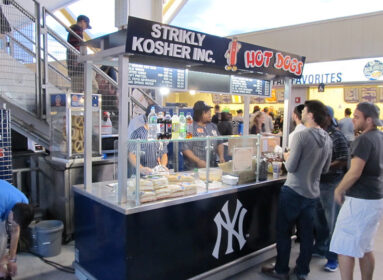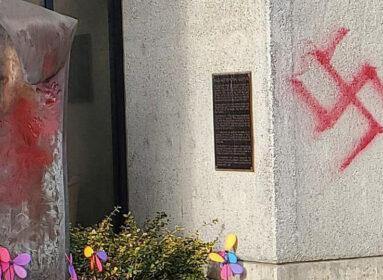
Jewish groups, elected officials, sports teams all look to Shine A Light on Jew-hatred
By Mike Wagenheim
(JNS) From Tampa Bay to Edmonton, a campaign intends to Shine A Light on antisemitism this Hanukkah.
“You can’t dispel darkness with darkness. You have to dispel darkness with light,” Adam Teitelbaum, executive director at the Israel Action Network and associate vice president for public affairs at Jewish Federations of North America, told JNS. “The ability to shine a light on the multiple ways in which antisemitism manifests in today’s society is an incredible opportunity for the coordination and collaboration of institutions across not only just the Jewish sector, but society writ large.”
The Shine A Light campaign, of which JFNA serves as a partner, is participating in missions across North America, bringing attention to the rise in Jew-hatred across the continent. It’s the second year Shine A Light is spearheading activities around Hanukkah celebrations.
“There’s a phrase that a mentor of mine used all the time that I think is so powerful: Conversations have beginnings, but they need not have ends. This is a good chance to start a conversation. It’s an excuse to start a conversation with people in the wider community,” said Teitelbaum.
This year, that includes the lighting up of menorahs and bridges, and Jewish communal events run in tandem with professional sports teams such as the NHL’s Tampa Bay Lightning.
Edmonton is continuing a program that started last year, as the city engages its provincial elected leadership with mosaic art around individuals’ experiences and understandings regarding antisemitism.
The Artists for Israel organization, meanwhile, will be unveiling a mural on a New York building that honors Tibor Baranski, a Righteous Among the Nations who saved more than 3,000 Hungarian Jews from the Nazis before being caught and surviving a death march and seven years in a Soviet prison.
Another event, which will include elected officials, is planned for Los Angeles.
“It’s on every level of community engagement that these programs are happening and it’s across the country with great geographic diversity, from Manhattan to the Jewish Federation of the Bluegrass in Louisville, Kentucky,” Teitelbaum said.
Other activities include a youth art competition, seminars, concerts and parties. There is also a virtual event scheduled highlighting the rise in antisemitism in online gaming, which Teitelbaum points to as a particular area of growing concern.
He indicated that this year’s Hanukkah-focused campaign is larger than last year’s, based in part on the worsening climate for Jews. Teitelbaum pointed to JFNA’s work on the LiveSecure initiative and the growth of the congressional-funded Nonprofit Security Grant Program, which has received consistent and significant increases, and JFNA’s existing community-based relationships springing from that work.
“So how do we leverage, supplement and grow what already exists in terms of those community-based capacities and relationships and give them tools and resources, direction, messaging information and opportunities to collaborate across sectors to raise awareness about antisemitism?” asked Teitelbaum. “So, that’s Shine A Light.”
Main Photo: Joy Getnick reads a Hanukkah storybook to her son Benjamin. (Credit: Jonathan Getnick)
Students’ sensory Chanukah cards shine light on disability
(JNS) For the fourth straight year, hundreds of students from Jewish day schools and Hebrew schools across the U.S., Canada, the United Kingdom and even Poland are learning about the care, rehabilitation and advancement of children with severe disabilities by creating unique “Sensory Chanukah Cards” that will lift the spirits of their peers at ADI, a network of specialized care and empowerment for the most vulnerable members of Israeli society.
The inspired young artists from more than 30 schools were spurred into action by one of the many inclusion-focused challenges posed by the organization’s “ADI Bechinuch” Disability Inclusion Program, a robust curriculum of interactive modules and STEM projects that highlight the importance of disability inclusion and transform the students into disability advocates and agents of change in their own communities.
Ahead of Chanukah, the students’ holiday masterpieces, which include bright colors, interesting textures and 3D elements that are fun for ADI’s residents and special education students with severe disabilities to look at and touch, are being delivered to the organization’s two centers in Jerusalem and the Negev by the boxful, underscoring just how easy and beautiful inclusion can be.
“In a world that is being darkened with hatred and intolerance, we need to teach our children to shine the light of empathy and compassion,” said Elie Klein, ADI’s Director of Development for the U.S. and Canada. “The ADI Bechinuch programming broaches the subject with ensitivity and imagination, employing fun and engaging lessons, activities and simulations to teach students of every age how to open their hearts and minds to the needs and challenges of others.”
“For example, this Chanukah-themed workshop first teaches students how art therapy is used to help our ADI family members with severe disabilities reach their greatest potentials before encouraging the students to use the same mediums to enhance the holiday for the ADI residents and special education students. In addition to presenting them with a compelling reason to do something thoughtful for others, the creative process becomes an opening for a class discussion about the abilities that can be found within every disability and how they can promote disability inclusion in their own communities and beyond.”
In the months ahead, the ADI Bechinuch partner schools, including many affiliated with Jewish National Fund-USA, will continue to explore the importance and impact of disability inclusion by completing interactive modules, taking virtual tours of ADI Jerusalem and ADI Negev-Nahalat Eran and creating simple STEM projects to enhance the lives of individuals with disabilities in their communities. In February, the schools will also participate in ADI’s “Make the Change Challenge,” an international STEM accessible design contest to mark Jewish Disability Awareness, Acceptance and Inclusion Month (JDAIM).
“The enthusiasm and genuine excitement with which the students at our ADI Bechinuch partner schools approach each element of the curriculum is nothing short of extraordinary,” added Klein. “It’s clear that these young leaders are not only beginning to understand the realities of disability and how it connects us all, but they are also internalizing the fact that they can take an active role in making the kind of inclusive changes we so desperately need in this world.”
ADI provides its residents and special education students with the individualized growth plans and specialized services they need to grow and thrive, its rehabilitation patients with the treatments and therapies they need to heal and return to their lives, and the community at large with tangible opportunities for encountering disability, raising awareness and promoting acceptance.
Main Photo: Students from the Epstein Hillel School in Marblehead, MA, are among hundreds of young disability advocates across the US, Canada, the UK and even Poland who created beautiful ‘Sensory Chanukah Cards’ during their ‘ADI Bechinuch’ workshops to brighten the holiday for ADI’s residents and special education students with severe disabilities.
Introducing…Crypto Gelt
(JNS) Chocolate ‘gelt’ is practically a Chanukah staple — almost right up there with the latke and dreidel.
Now, this year the Manischewitz company is taking the classic gold and silver foil covered treat a step further with the launch a brand-new product that enhance the holiday. Introducing Manischewitz Crypto Gelt: the most revolutionary innovation in the field of Chanukah since the introduction of the dreidel itself!
It’s 2022, after all… traditional coins are a relic of the past – most often found in between couch cushions, not your bank account. Trade in your traditional chocolate coins for Manischewitz Crypto Gelt – sure to be the smartest (and tastiest!) crypto investment in your portfolio.
But fear not – unlike traditional cryptocurrencies, like Bitcoin and Ethereum, which are completely digital, usually without physical form– Manischewitz Crypto Gelt is made from milk chocolate, in packaging that mirrors the most well-known logos of popular cryptocurrency. Wrapped in gold, Manischewitz Crypto Gelt can be easily identified by their resemblance to real gold coins, with a stylized ‘M’ (for Manischewitz, of course!) with vertical strokes from the dollar sign incorporated above and below to exude a visual nod to the dollar sign.
The Crypto Gelt is sold in a package of 36 bags or in individual bags with 4 coins per bag. It can be found in leading supermarket and retail chains or online outlets including Amazon. To purchase on Amazon, visit the Manischewitz Amazon store, or follow this link: https://a.co/d/aPj1AnF.
The Manischewitz Company has been making traditional Jewish foods since it first opened a small matzo bakery in Cincinnati, Ohio in the late 1800s. Today, Manischewitz is part of the Kayco family of brands, offering one of the largest assortments of kosher foods and beverages. For more information, visit https://manischewitz.com/.
Archaeologists: 2,200-year-old sling bullet may be linked to Chanukah story
(JNS) Israeli researchers recently discovered a lead projectile dating from the Hellenistic period in the ancient palace at Yavne, an archaeological site in central Israel.
The 4.4 centimeter (1.7 inch) long projectile was designed to be launched from a sling. It is estimated to be 2,200 years old, placing it at the time of the battles between the Hasmoneans and the Seleucid Empire.
The story of Chanukah, celebrated this year between Dec. 18-26, commemorates the recapture of Jerusalem from the Seleucids in the second century B.C.E.
“It seems that we will not be able to know for sure if the projectile belonged to a Greek soldier,” said Pablo Bezer and Daniel Varga, managers of the Yavne archaeological site for the Israel Antiquities Authority.
“But it is not impossible that it is related to the conflict between the Greeks and the Hasmoneans. In the second century B.C.E., Yavne was pagan—an ally of the Seleucids [the Greeks who ruled Israel], and was subject to attacks by the Hasmonean armies,” they added.
The projectile bears a Greek inscription: “Victory for Heracles and Hauron.”
Yulia Ustinova of Ben-Gurion University, who decoded the inscription, explained, “The pair of gods Hauron and Heracles were considered divine patrons of Yavne during the Hellenistic period. The inscription on a projectile is the first archaeological evidence of the two protectors of Yavne that was discovered inside Yavne itself. Until today, the pair was only known from one inscription on the Greek island of Delos.”
The inscription was not a call to the deities, but rather “a threat addressed to the adversaries. The inscriptions conveyed a message to unite the warriors, scare the enemy or a call to goad, in a magical way, the bullet itself. These were parts of psychological warfare,” she added.
The find is rare, she added. “Lead bullets are known in the ancient world starting from the 5th century B.C.E, but in Israel few individual bullets have been found with inscriptions on them.”
Chanukah Briefs
White House unveils Chanukah menorah as part of official Christmas decorations for first time
(JNS) As part of its annual Christmas decorations tradition, the White House has unveiled a new addition: a menorah in celebration of Chanukah.
The menorah is included in Cross Hall, a broad hallway on the first floor of the House, underneath a wreath. It is positioned between the portraits of presidents Jimmy Carter and Lyndon Johnson.
According to the White House, the menorah was constructed by the Executive Residence Carpentry Shop from wood leftover from the 1950s-era renovation during Harry Truman’s presidency.
Menorahs have previously been lit in the White House, but this is the first time one has been included as part of an official display. The positioning near the Carter portrait is apt, as he was the first president to celebrate the holiday with a lighting of a menorah in 1979. In 2001, George W. Bush was the first president to host a Chanukah party, lighting a menorah in the White House residence.
Last year, President Joe Biden and First Lady Jill Biden also hosted a menorah lighting, attended by Second Gentleman Doug Emhoff and Israeli Ambassador to the U.S. Michael Herzog.
“You know, when we light this menorah in the White House, when Jewish families place menorahs in their windows, we are proclaiming liberty,” Biden said at the time. “We’re exercising the freedom that the Maccabees sought to simply practice their faith. And we’re showing that there is still light, that even the most fragile flame can be sustained in a tradition and nourish the soul of a people.”
Yeshivah U Museum to display rare menorah from Maimonides manuscript
(JNS) The Yeshiva University Museum has announced that its upcoming exhibition will feature a hand-drawn illustration of the Temple menorah from a manuscript that contains notes by the famed Jewish sage Maimonides (Rambam).
The exhibition, “The Golden Path: Maimonides Across Eight Centuries,” will run from May 9-Dec. 31, 2023, at the museum in New York City. It will also feature a copy of the Rambam’s Mishneh Torah that was reportedly personally signed by Maimonides. The Temple menorah drawing is found in a 12th-century copy of the Rambam’s “Commentary on the Mishnah,” with his handwritten notes in the margins.
The drawing of the Temple menorah shows seven straight, rather than curved, branches. This unique image of the holy gold candelabra may have been drawn by Maimonides himself, according to a press release from the museum.
Other items to be featured include rare pieces on loan from the Bodleian Library in Oxford, the British Library, the Royal Danish Library, the Mantua State Archive of the Italian Ministry of Culture and the National Library of Israel.
“The partnerships with international collections are unprecedented, and the exhibition stands to be one of the most impressive collections of Maimonides artifacts ever to be displayed together,” said Gabriel Goldstein, director and chief curator of the Yeshiva University Museum.








 Southern New England Jewish Ledger
Southern New England Jewish Ledger









